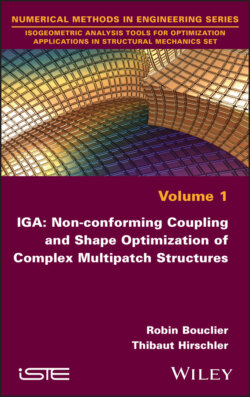Читать книгу IGA - Robin Bouclier - Страница 26
1.3.2. An ideal framework for parametric shape optimization
ОглавлениеAlthough a proper introduction of structural isogeometric shape optimization will not be given until Chapter 4 (see, in particular, section 4.2 for a general discussion), we can already suspect the benefit of combining high-quality geometric representations and efficient analysis capabilities into one single model for this area of research. Indeed, without providing details yet, shape optimization involves an iterative process with three principal steps, as explained in, for example, Bletzinger (2014) and illustrated in Figure 1.15. Depending on the choices performed to describe the design model (i.e. the geometrical model where the design variables allowing for shape modification are defined; see the top box in Figure 1.15), the transitions between these steps (the blue arrows in Figure 1.15) can become quite tedious in classic FEM.
Figure 1.15. Main steps for shape optimization (inspired from Bletzinger (2014)): difficulties can occur during the transition from one step to the other when either the CAD-based or the FE-based approach is used. For a color version of this figure, see www.iste.co.uk/bouclier/IGA.zip
Basically, two main approaches exist in standard FEM to carry out the shape optimization of structures. The first one, usually classified as the FE-based optimization alternative in the field, consists of using the spatial location of the FE nodes as the design variables (i.e. the variables that update the geometrical shape) (Bletzinger et al. 2010; Le et al. 2011; Firl et al. 2013; Bletzinger 2014). The interest is that the design model is directly usable for structural analysis (see the bottom-right box in Figure 1.15). However, important difficulties are encountered when treating the large number of design parameters. Indeed, the number of nodes of an FE mesh is often significant. Thus, delicate mesh regularization techniques need to be put in place to prevent the appearance of irregular, “unrealistic” shapes (Firl et al. 2013; Bletzinger 2014) (see top-left arrow in Figure 1.15). In the same idea, special care is needed to exploit the results coming from the FE structural analysis, such that appropriate shape updates could be computed through the optimization process (see the bottom arrow in Figure 1.15). Furthermore, at the end of the process, it is almost always required to convert the FE results in terms of CAD-suitable data for production. Conversely, the second class of techniques, denoted by the CAD-based approach, proposes to resort to the same spline-based functions as in CAD software to describe the design model (Braibant and Fleury 1984; Olhoff et al. 1991; Ramm et al. 1993). Hence, this time, the design variables are the spatial locations of the control points of the spline entities, which bring very appealing features to proceed the shape design step (see discussion in section 1.2.3). The difficulty with this second family of methods is then transferred to the connection of the design model and the analysis model (Hasan Imam 1982; Bletzinger et al. 1992) (see the top-right arrow in Figure 1.15). Indeed, in the CAD-based approach, the design model is based on splines, while the analysis model is based on standard FE. A meshing step separates both models. This also creates drawbacks when exploiting the results from the structural analysis (see the bottom arrow in Figure 1.15) since these come from the FE analysis model and should be transferred back to the spline design model.
Benefiting from the discussion of section 1.3.1, it is obvious that one way to naturally communicate between the design and analysis models is to use the IGA framework, as it enables us to get an analysis model made of splines functions. Hence, isogeometric shape optimization has been successfully applied to a wide range of applications since the advent of IGA (see Wall et al. (2008); Nagy et al. (2010, 2011, 2013); Qian (2010); Kiendl et al. (2014); Taheri and Hassani (2014); Fußeder et al. (2015); Wang and Turteltaub (2015); Kang and Youn (2016); Herrema et al. (2017); Lian et al. (2017); Choi and Cho (2018); Lei et al. (2018); Hirschler et al. (2019b); Weeger et al. (2019) among others). It concerns not only structural shape optimization, but also other fields, such as heat conduction (Wang et al. 2017b), electromagnetics (Nguyen et al. 2012; Dang Manh et al. 2014), fluid mechanics (Park et al. 2013) and many other optimization problems.
